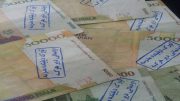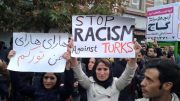Azerbaijanis living in this country (both in Southern Azerbaijan and other parts of Iran) always played an important and active role in the socio-political life of Iran, almost at every age of its existence. According to different sources, Azerbaijanis constitute from 16 to 40 % of Iran’s population. In 1905, Azerbaijanis led by Sattarkhan were a backbone of the revolution in Iran. Southern Azerbaijan and its historical capital Tabriz have long been the main impenetrable fortresses of the Iranian revolution. It is noteworthy Iran was governed by Azerbaijani Qajar dynasty that time. In 1945-46, “Azerbaijan People’s Government” headed by Sayyed Ja’far Pishevari was working in Tabriz. Shah Mohammad Reza Pahlavi was ruling in Tehran. After Soviet troops had left Southern Azerbaijan, Pishevari Government officials negotiated a relative autonomy of Southern Azerbaijan with Shah’s Government. However, shortly after that, Shah’s Government broke the agreement and the army entered Southern Azerbaijan. A great number of Azerbaijanis were murdered and imprisoned. Others, led by Pishevari, could escape to Northern Azerbaijan.
Southern Azerbaijan was one of the strongholds during the Islamic revolution in 1978-79. After the overthrow of Shah’s regime, two Azerbaijanis Ayatollah Khomeini and Mehdi Bazargan took the helm of the country. But, again, hopes of Azerbaijani people for, at least, national cultural autonomy were not realized. The new regime started to spread “Shia identity”, trying to replace the national identity of non-indigenous peoples of Iran. Azerbaijanis quickly realized that Khomeini is not going to grant autonomy neither them, nor someone else. This frustration degenerated into rebellions in December-January 1979-80, mainly in Tabriz.
An Azerbaijani from Tabriz, Ayatollah Shariatmadari was a silent leader and mastermind of the rebellion. Though the initial period was successful for the rebels, their insurgency was broken under the pressure of Khomeini’s supporters.

It should be noted, that during the revolutionary events in 1978-79, Azerbaijanis largely supported more moderate Ayatollah Shariatmadari rather than fanatic Khomeini. Such slogans as “Death to Khomeini” were frequent during the Azerbaijani rebellion in 1979-1980.
Protests of Azerbaijani population break out in Southern Azerbaijan from time to time. The main reason for this – racist acts against Azerbaijani people in Teheran media outlets.
Though the current Supreme Leader of Iran Ali Khamenei is Azerbaijani, his policy toward Southern Azerbaijan and rights of the Azerbaijani people is the same as Khomeini’s policy.
It is noteworthy that Azerbaijanis in Iran hold strong positions in business, political elite and IRGC. Possible clashes may partially undermine this deal. The existence of a secular Azerbaijan Republic on Iran’s northern borders may encourage Azerbaijani activists in Southern Azerbaijan on one hand and be Iran’s headache on the other.
It is noteworthy that tens of millions of Azerbaijanis live in Iran, but they are unable to receive education in their own language. Education in their mother tongue is one of the main requires of Azerbaijanis.
USA, Israel, Saudi Arabia and any other country can anytime use this “Achiless hill” of Iran and this possibility is one of the nightmares of the Mullocraсy in Tehran.
A question in the minds of many is why Azerbaijanis have not joined the protests in Iran, started in the last few days of December.
There are several factors.
- Khomeini’s propaganda has made its toll and a part of the Azerbaijani people has put their religious identity, instead of the national, in front.
- An active and nationalistic-oriented part of Azerbaijani society (mainly citizens) have given up on Iranian revolutions and rebellions. They think their position would not get better under any scenario.
- A more radical part of Azerbaijanis believes they will get their rights only in case they create their own State. That is why they see no need to participate in Iranian internal confrontations. It is better to wait for the right moment.
- A small number of people took part in rallies in certain cities of Southern Azerbaijan. Their amount cannot affect the course of events, and these people are not the radical wing members.
Some, at first glance, ordinary and little known in the West facts are worth noting. A football game between “Tractor” from Tabriz and Tehran “Persepolis” took place in Tehran on December 28. Many incidents and assaults on national foundations by “Persepolis” fans against those who came to support “Tractor” happened before, during and after the game. “Persepolis” fans were chanting insults against Azerbaijanis during the match. This, of course, was not able to remain unnoticed in Southern Azerbaijan, particularly in Tabriz. That is why when the protests spread to other cities of Iran, many Azerbaijanis thought these protests possess internal nature and are not relevant to them…
Güney Azerbaycan milləti niyə kütləvi olarax etirazlara qoşulmur? Çünki bu etiraz iranlıların etirazıdı, millət özünü İran adlanan yerin vətəndaşı görməx istəmir daha!#SouthAzerbaijan #Tabriz #Ardabil #Urmia #IranianProtests #IranProtesters
— CLSA (@_CLSA_) 4 января 2018 г.
Right now, certain Iranian nationalistic media outlets and Telegram-channels (Telegram is the most popular means of communication in Iran, despite the official service block) offend Azerbaijanis, accusing them of “cooperation with Iran’s enemies”. The Iranian news agency “Tasnim News”, controlled by the Government, went even further publishing a caricature, which depicts hands with the flags of USA, Israel and Saudi Arabia and a wolf-like shadow falling on the Iranian flag.

(A wolf has an important place in the Turkic mythology, Azerbaijani and Turkish nationalists often use a picture of a wolf (Bozkurt), to define their position. This way they suggest that Iranian Azerbaijanis are supporting those countries.





Be the first to comment at "Why Southern Azerbaijanis are indifferent to the new “Iranian Revolution”?"